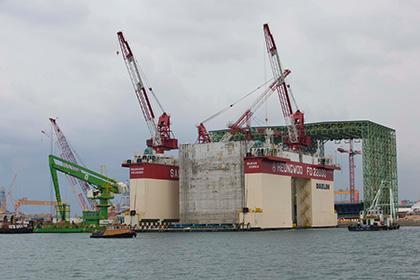Phase 1 of Tuas Terminal Development Begins
Singapore’s Tuas Terminal development has entered Phase 1 of its construction. When completed, the 20 deep-water berths in Phase 1 of Tuas Terminal development will be able to handle about 20 million TEUs per annum. The entire mega-terminal will have a total capacity of up to 65 million TEUs.
.png) A major component of Singapore’s next generation port vision, Tuas Terminal will incorporate new features such as optimizing land use by utilizing both above and underground spaces for complementary purposes like storage facilities; enhancing the safety and security of the port waters via a next generation traffic management system; and increasing productivity and reducing labor costs through the use of technology like automated yard cranes and port equipment.
A major component of Singapore’s next generation port vision, Tuas Terminal will incorporate new features such as optimizing land use by utilizing both above and underground spaces for complementary purposes like storage facilities; enhancing the safety and security of the port waters via a next generation traffic management system; and increasing productivity and reducing labor costs through the use of technology like automated yard cranes and port equipment.
Coordinating Minister for Infrastructure and Minister for Transport Khaw Boon Wan marked the initiation ceremony by launching the first caisson. In total, 222 such caissons will form the permanent wharf structure. With each caisson 28 meters tall and equivalent to the height of a 10-storey building, the caissons designed for Tuas Terminal Phase 1 are one of the largest in the world.
 The Tuas Terminal will be developed in four phases over the span of some 30 years, with the Phase 1 reclamation works scheduled to be completed by the early 2020s. In February 2015, the Maritime and Port Authority of Singapore (MPA) appointed the DIAP-Daelim Joint Venture to carry out the land reclamation and related works for Tuas Terminal Phase 1 development. The works will include reclaiming 294 hectares of land, dredging the Tuas basin and Temasek Fairway, as well as constructing the wharf structure.
The Tuas Terminal will be developed in four phases over the span of some 30 years, with the Phase 1 reclamation works scheduled to be completed by the early 2020s. In February 2015, the Maritime and Port Authority of Singapore (MPA) appointed the DIAP-Daelim Joint Venture to carry out the land reclamation and related works for Tuas Terminal Phase 1 development. The works will include reclaiming 294 hectares of land, dredging the Tuas basin and Temasek Fairway, as well as constructing the wharf structure.
 The DIAP-Daelim Joint Venture will use cutting-edge equipment and techniques to maximize efficiency. It will mobilize, among others, the world’s largest grab dredger and one of the world’s most powerful cutter suction dredgers, along with a wide range of other dredging and reclamation equipment.
The DIAP-Daelim Joint Venture will use cutting-edge equipment and techniques to maximize efficiency. It will mobilize, among others, the world’s largest grab dredger and one of the world’s most powerful cutter suction dredgers, along with a wide range of other dredging and reclamation equipment.
In addition, the use of soil improvement techniques will allow the dredged materials from the deepening of basins and nearby fairway, as well as excavated earth obtained from other land construction projects, to be reused as reclamation fill materials for the project. Reusing such materials, which would otherwise be disposed of, reduces the quantity of sand fill required for reclamation, resulting in fill material cost savings of some S$1 billion.
